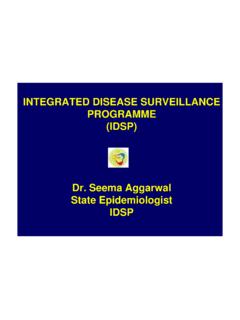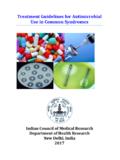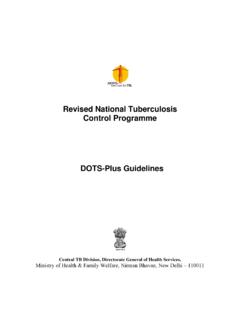Transcription of NATIONAL VECTOR BORNE DISEASE CONTROL …
1 NATIONAL VECTOR BORNE DISEASE CONTROL PROGRAMME (NVBDCP) INTRODUCTION: The NATIONAL VECTOR BORNE DISEASE CONTROL Programme (NVBDCP) is an umbrella programme for prevention and CONTROL of VECTOR BORNE diseases. Earlier the VECTOR BORNE Diseases were managed under separate NATIONAL Health Programmes, but now NVBDCP covers all 6 VECTOR BORNE diseases namely: 1. malaria 2. Dengue 3. Chikungunya 4. Japanese Encephalitis 5. Kala-Azar 6. Filaria (Lymphatic Filariasis) malaria At the time of independence, there were an estimated 75 million cases of malaria and million deaths due to malaria were being reported annually. Government of india launched NATIONAL malaria CONTROL Programme (NMCP) in 1953. Under this programme indoor residual spray was being done with DDT twice a year. As a result, incidence of malaria cases came down from 75 million cases in 1953 to 2 million cases in 1958 in india .
2 In 1958 this CONTROL programme was switched over to NATIONAL malaria Eradication Programme (NMEP), under which initially every house in the State was to be sprayed with DDT twice a year. Later on, spraying was with-drawn but surveillance activities were carried out vigorously. This went on but gradually malaria incidence began to rise. In Punjab State the number of malaria cases went from 321 in 1966 to 5 lac in 1977. Due to this set back to the programme a revised strategy was started called Modified Plan of Operation (MPO) Under this all the rural population and towns having less than 40,000 populations were under active surveillance. Every dwelling unit is visited by health worker fortnightly to detect fever cases and to give presumptive treatment to them against malaria . Radical treatment was administered to declared positive cases. THE MAIN FEATURES OF THIS PROGRAMME ARE AS FOLLOWS:- 7.
3 Surveillance 8. malaria Clinics 9. Drug Distribution Centers(DDCs) 10. Fever treatment Depots(FTDs) 11. Spray Operations 12. Urban malaria Scheme(UMS) SURVEILLANCE A) ACTIVE SURVEILLANCE:- Under this, the fortnightly domiciliary visits are made by MPHW (M) under primary health care system & by this fortnightly visit large number of secondary cases can be avoided where malaria transmission is seasonal. The components of active surveillance are:- 1. Search for fever cases 2. Collection of Blood smears from fever cases. 3. Administration of appropriate presumptive treatment . malaria surveillance includes maintenance of on going watch over the status of malaria in a group or community. It provides a basis for measuring effectiveness of anti malaria programme and helps CONTROL measures. malaria surveillance presumes that every malaria case presents itself with symptoms of fever at some point of time during the course of infection.
4 These all fever cases are examined for blood smears to know the malaria parasite load. malaria Surveillance Includes:- Laboratory confirmation of presumptive diagnosis. To find out the source of the infection. Identification of cases and susceptible contacts in order to prevent further spread of DISEASE . The timely collection and examination of blood smears is the key elements in the NATIONAL malaria CONTROL strategy. By giving early radical treatment to detected cases, the human reservoir of malaria parasite is reduced. B) PASSIVE SURVEILLANCE:- All the health institutions screen the fever cases visiting the hospital for malaria by blood slides collection. Achievements for the year 2007,2008 and 2009 (upto September is as under:- Year Blood slides target (10% of population ) No. of Blood slides collected % achievement Total malaria +ve cases cases 2007 2664628 2723253 2017 41 2008 2695967 2979882 2494 38 2009 upto Sept.
5 2751159 2273310 110 2633 20 C) malaria Clinic:- malaria Clinics are working in the state in Medical Institutions where the blood slides are examined same day and Radical treatment is also given to positive cases on the spot. Achievements:- Year No. of malaria Clinics Blood slides collected Found +ve Radical treatment 2007 604 440264 1078 1078 2008 608 419498 1049 1049 2009 upto Sept. 623 298046 1393 1393 D) Drug Distribution Center (DDCs):- Anti malaria drugs are distributed to fever cases through Drug Distribution Centre (DDC) in the village; free of cost . The DDC s do not collect blood slides but administer presumptive treatment to fever cases. As per revised NATIONAL malaria Drug Policy 2008 DDCs are being phased out and instead establishment of FTDs is being promoted. Achievements:- Year No. of DDC Established No. of treated without blood slides 2007 16772 444411 2008 16374 218191 2009 upto Sept.
6 471 72937 13. Fever treatment Depots (FTD):- Fever treatment Depots have been established in villages of Punjab which are remote and with low population density to detect malaria at the earliest cases is by collection of blood slides Community members are involved by imparting training blood slides collection and rendering treatment . Achievements:- Year No. of FTD Blood Slides Collection/ Examined Found +ve Radical treatment 2007 1146 30105 1 1 2008 1162 27497 6 6 2009 upto Sept. 5008 39778 28 28 F) SPRAY OPERATION:- As per Modified Plan of spray operation of Government of india in a Sub Centre having population 1000 and ( Annual parasite Index ) 2 or more than 2 of malaria Positive cases in any year during last three years, spray operation is carried out. The spray operation is commenced on 15th may lasts till 30th September every year. DDT & Malathion are used for IRS ( Indoor residual Spray) as per policy of GOI.
7 G) Urban malaria Scheme :- Urban malaria Scheme is being implemented in 21 towns of Punjab State Amritsar, Jalandhar, Patiala, Ferozepur, Malerkotla, Bathinda, Kapurthala, Rajpura, Nabha, Jagraon, Hoshiarpur, Gurdaspur, Ludhiana, Sangrur, Barnala, SAS Nargar, Phagwara, Khanna, Faridkot, Malout and Tarn Taran In these towns , breeding of mosquitoes is checked by carrying out Anti Larval Operations regularly at weekly intervals in the following manner: a) SOURCE REDUCTION:- Permanent & Temporary breeding sources of mosquitoes are eliminated by filling of burrow pits, ditches, small irrigation canal and unused well. b) CHEMICALS AGAINST VECTOR MOSQUITO LARVES:- Fenthion, Temphos and Bti larvicides are used to eliminate larvae of VECTOR Mosquito . malaria DRUG POLICY: Government of india revises the drug policy for treatment of malaria and suspected malaria patients.
8 New drug policy has been revised in 2008 with strong emphasis on: a) The presumptive treatment given earlier in the programme to all the fever cases after collection of the blood slide has been stopped and radical treatment is given after confirmation of the blood slide in the laboratory. b) The radical treatment with Primaquine being given to malaria positive patients has been increased to 14 days. c) The fever cases found by the staff in far flung areas, looking like a malarai case can be given full course of Chloroquine after labelling it as a case of clinical malaria and the radical treatment can be given after laboratory confirmation of the case. DENGUE & CHIKUNGUNYA Dengue is a self limiting viral DISEASE , caused by the bite of infected Aedes aegypti mosquitoes. These mosquitoes are day biters & outbreaks are sustained by human mosquito human transmission.
9 The peak biting times of the Aedes aegypti mosquito are early morning or late evening. These mosquitoes usually breed in clean water collections in containers, tanks, disposable junk material such as discarded buckets utensils tyres flower pots etc. So all such containers should be emptied regularly, atleast once a week to stop breeding of these mosquitos Health education is imparted to create awareness in the community regarding preventive measures against Dengue Fever:- Year wise detail of Dengue cases in Punjab State is as under:- Year Total Dengue Cases Deaths Chikungunya Death 2007 28 Nil NIL NIL 2008 4349 21 NIL NIL 2009 upto Sept. 1 NIL NIL NIL PREVENTION AND CARE OF DENGUE & CHIKENGUNYA :- The department of Health and Family Welfare has curative, preventive and educative role to prevent and CONTROL of Dengue fever. Five Sentinel Surveillance Centres have been approved for Punjab by Govt of india in 2009 thus increasing the number of there centers to six.
10 1. Govt Medical College Amritsar. 2. Govt Medical College Patiala 3. Civil Hospital Jallandhar 4. Civil Hospital Ludhiana 5. Civil Hospital Bathinda 6. Civil Hospital Mohali Testing of all dengue cases done free of cost at these centres. Blood component separators have been installed at Civil Hospital Ropar, Hoshiarpur, Pathankot, Ludhiana, Jalandhar, Bathinda and Ferozepur Hospitals and Medical collages Patiala and Amritsar. In the remaining districts blood component separator unit are being installed in the District Hospitals Aphoresis Machines are being installed in six districts, namely Ludhiana, Amritsar, Jalandhar, Sangrur, Bathinda and SAS Nagar. Microbiologists/ Pathologists of these districts had got training for working of Aphoresis Machines at PGI Chandigarh from 23-7-2009 to 6-8-2009. Special dengue wards are reserved in hospitals for free of cost treatment of dengue cases. Training to Senior Medical Officer, Medical Officer, Multipurpose Health Supervisor, MPHW (M),LT has been imparted under NATIONAL VECTOR BORNE CONTROL DISEASE Programme.







